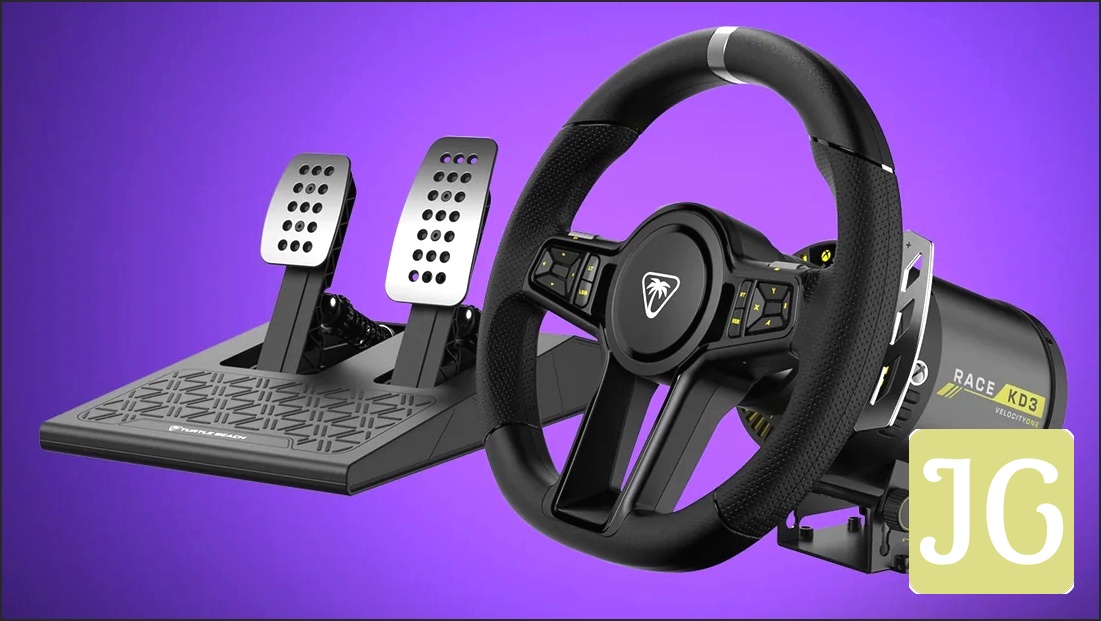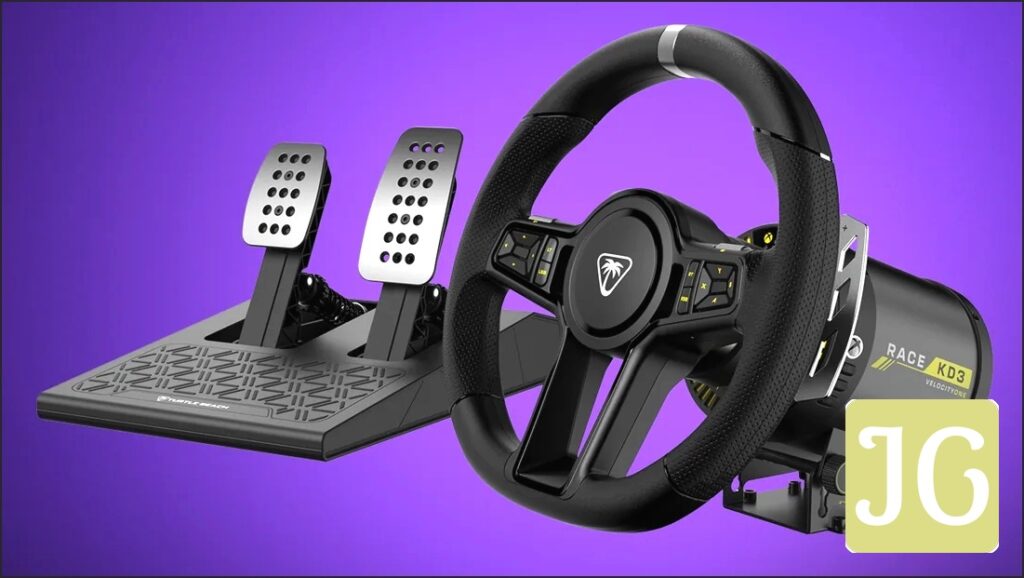In a move that has certainly piqued curiosity while simultaneously igniting a healthy dose of skepticism within the sim racing community, Turtle Beach, a brand synonymous with gaming audio, has officially entered the highly competitive sim racing hardware market. With the unveiling of three new peripherals—the VelocityOne Race KD3 wheel and pedal system, the VelocityOne F-RX formula wheel, and the casual-focused Racer wireless wheel—Turtle Beach aims to challenge the long-standing dominance of established giants like Fanatec, Logitech, and Thrustmaster. This audacious expansion sets the stage for a critical evaluation: can a newcomer truly carve out a significant niche, or is this a risky bet in a segment fiercely loyal to proven performance?
Turtle Beach Enters the Race: A New Era or a Risky Bet?
Turtle Beach Corporation, a leading gaming accessories maker, formally announced its ambitious foray into the sim racing market with three distinct products designed to cater to a broad spectrum of users. The flagship offering, the Turtle Beach VelocityOne Race KD3, is a comprehensive racing wheel and pedal system, priced at an MSRP of $449.99. Complementing this is the VelocityOne F-RX, a dedicated formula-style wheel retailing for $249.99. For the more casual player, Turtle Beach introduced the Racer, a wireless wheel designed for versatility, available at $179.99. All three products are slated for a simultaneous global launch on September 9, 2025, and are currently available for pre-order through Turtle Beach’s official website and global retailers. According to Cris Keirn, CEO of Turtle Beach, this launch marks a strategic expansion of the VelocityOne ecosystem into the racing category, with each product featuring intuitive designs and innovative features tailored for users of all levels.
Product Feature Highlights
Turtle Beach VelocityOne Race KD3
Type: Direct-Drive Racing Wheel & Pedals
- 3.2 Nm K: Drive™ direct-drive motor with ultra-low latency
- Up to 2,160 degrees of rotation
- Magnetic paddle shifters for precise shifts
- Integrated Race Management Display™ for on-the-fly profile customization
- Adjustable aluminum pedals and modular design
- Compatible with Xbox and Windows
Turtle Beach VelocityOne F-RX
Type: Formula-Style Wheel
- Aluminum construction with quick-release design
- 10 mechanical switches with RGB backlighting
- 5 rotary dials for quick function access
- Dual magnetic paddle shifters and two clutch paddles
- Dedicated LED RPM dashboard
- Made with premium, racing-grade materials
- Compatible with K: Drive™ wheelbases (VelocityOne Race & KD3 systems)
Turtle Beach Racer
Type: Wireless Racing Wheel
- 2.4 GHz low latency wireless connection with 30-foot range
- Up to 30 hours of battery life
- Non-slip, adjustable lap mount or integrated table clamps
- Controller mode for compatibility with games not supporting racing wheels (e.g., Rocket Racing)
- Designed for Xbox and compatible with Windows

The 3.2Nm Question: Can Less Be More in Direct Drive?
The cornerstone of Turtle Beach’s sim racing ambition is the VelocityOne Race KD3, featuring a 3.2Nm direct-drive motor. From a purely empirical standpoint, this figure immediately raises questions within a market where the average direct-drive motor typically delivers between 5Nm and 8Nm of output from established competitors like Fanatec and Logitech. A lower torque output, such as 3.2Nm, inherently means a less potent force feedback system. While Turtle Beach positions the KD3 as an ‘entry-level’ direct-drive product, the community’s skepticism is well-founded: will 3.2Nm provide the fidelity and raw immersion expected from direct-drive technology, particularly when replicating the nuanced forces of a race car? The concern is that a weaker motor might struggle to convey subtle road textures, tire slip, and collision impacts with the clarity and strength that higher-torque direct-drive wheels offer. While a lower Nm might reduce the entry barrier for direct-drive technology, the critical performance metric will be whether this output is sufficient to deliver a truly competitive and immersive experience, or if it represents a compromise that will fall short for discerning sim racers accustomed to more robust feedback.
Turtle Beach VelocityOne Race KD3 vs. Direct Drive Competitors
Turtle Beach VelocityOne Race KD3
Price: $449.99
Peak Force Feedback: 3.2 Nm
Rotation Degrees: Up to 2,160°
Notable Features:
- Magnetic paddle shifters
- Race Management Display™
- Adjustable aluminum pedals
- K: Drive™ direct-drive motor
Typical Direct Drive Competitor (e.g., Fanatec CSL DD, Logitech G Pro)
Price: Variable (often higher)
Peak Force Feedback: 5-8 Nm (Industry Average)
Rotation Degrees: Varies by model
Notable Features:
- Higher peak torque for enhanced fidelity
- Established ecosystem support
- Proven track record in sim racing community
Note: Specific competitor pricing and features vary widely. The comparison highlights where the KD3 stands relative to the average direct-drive market output as per available data.
Beyond the Specs: Addressing Community Concerns
Beyond the quantifiable specifications, the broader sim racing community—known for its discerning nature and fierce brand loyalty—has voiced significant skepticism regarding Turtle Beach’s entry. A primary concern, given Turtle Beach’s history primarily in audio peripherals, revolves around overall build quality and the long-term durability of components, particularly the ‘premium, racing-grade materials’ claimed for products like the F-RX. There is a notable absence of direct reviews from the sim racing community concerning the build quality, software stability, driver compatibility, and setup complexity of these new peripherals. This lack of empirical validation fuels apprehension. Furthermore, the Turtle Beach Racer, with its wireless connectivity, faces inherent questions regarding input precision and longevity, especially in competitive racing scenarios where every millisecond and consistent input matters. The comfort and stability of its unique lap mount technology, while offering versatility, also remain unproven over extended, high-intensity use compared to traditional, rigid mounting solutions. For hardware validation, the absence of comprehensive performance data and long-term reliability reports is a significant red flag.
Anticipated Pros & Cons of New Turtle Beach Racing Peripherals
VelocityOne Race KD3
- ✓ Entry-level direct-drive pricing ($449.99)
- ✓ Integrated Race Management Display™ and Tuner app for customization
- ✓ Magnetic paddle shifters and adjustable pedals
- ✓ Designed for Xbox & Windows compatibility
- ✖ Lower 3.2Nm direct-drive torque compared to industry average (5-8Nm)
- ✖ Unproven build quality and long-term durability in sim racing context
- ✖ Potential for software stability and driver compatibility issues (no community reviews yet)
VelocityOne F-RX
- ✓ Dedicated formula-style wheel with aluminum construction
- ✓ Extensive button layout (10 mechanical, 5 rotary dials) and dual clutch system
- ✓ Quick-release design for modularity
- ✓ Compatible with K: Drive™ wheelbases
- ✖ Claims of ‘premium, racing-grade materials’ are unverified by community reviews
- ✖ No direct community feedback on ergonomic comfort or long-term reliability
- ✖ Requires a separate K: Drive™ wheelbase for operation
Racer
- ✓ Highly versatile with non-slip lap mount and integrated table clamps
- ✓ Wireless 2.4 GHz connection with up to 30 hours battery life
- ✓ Controller mode for broader game compatibility (e.g., Rocket Racing)
- ✓ Budget-friendly entry point ($179.99)
- ✖ Community concerns regarding wireless input precision and longevity in competitive racing
- ✖ Lap mount technology may be less comfortable or stable over long sessions
- ✖ Overall build quality and durability for a wireless wheel are unproven
Key Takeaways
Turtle Beach’s ambitious leap into the direct-drive sim racing market is a calculated risk, signaling a clear intent to expand beyond its headset stronghold. While the pricing structure for the VelocityOne Race KD3, F-RX, and Racer is intriguing, offering seemingly accessible entry points into various segments of racing, the empirical evidence required for definitive performance validation is currently absent. The real crucible for these peripherals will be in the hands of the sim racing community—through rigorous, independent reviews and sustained long-term adoption. Given the deep-seated brand loyalty that characterizes this market, Turtle Beach faces an uphill battle to prove that its new hardware can deliver the consistent performance, precision, and durability demanded by serious racers. Whether Turtle Beach can truly carve out a significant, respected niche in this competitive landscape remains entirely dependent on their ability to translate marketing claims into verifiable, high-performance reality.
Frequently Asked Questions About New Turtle Beach Racing Peripherals
What is the release date for the new Turtle Beach racing wheels?
All three new Turtle Beach racing peripherals—the VelocityOne Race KD3, VelocityOne F-RX, and Racer—are scheduled to launch simultaneously on Tuesday, September 9, 2025. They are currently available for pre-order.
Are these compatible with PlayStation?
No, the new Turtle Beach racing wheel products are part of the ‘Designed for Xbox’ lineup and are compatible with Xbox Series X, Xbox Series S, and Windows PCs only, according to current official specifications.
How does the 3.2Nm direct drive compare to gear-driven wheels?
The Turtle Beach VelocityOne Race KD3 features a 3.2Nm direct-drive motor. Direct-drive technology generally offers superior force feedback fidelity, responsiveness, and detail compared to gear-driven or belt-driven systems due to the motor being directly connected to the wheel. While 3.2Nm is on the lower end for direct-drive systems (which typically range from 5-8Nm), it represents a significant upgrade in feedback quality over most gear-driven wheels. However, direct empirical comparison data between the KD3’s 3.2Nm output and specific gear-driven wheels is not provided in the available facts.
Can the Racer wheel be used with games like Rocket Racing?
Yes, the Turtle Beach Racer wireless wheel features a ‘controller mode’ that allows it to be used as a wheel in driving games that do not natively support racing wheels, such as Rocket Racing. This enhances its versatility for casual racing gameplay.

